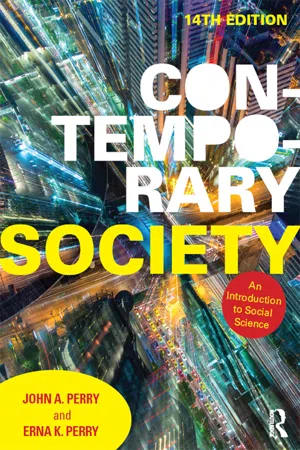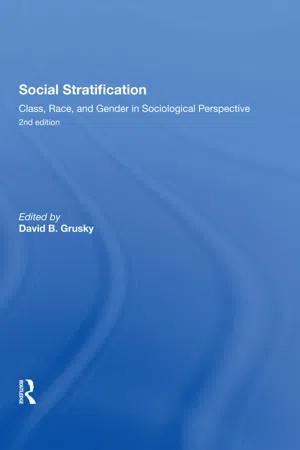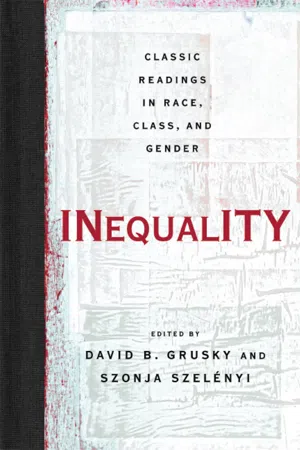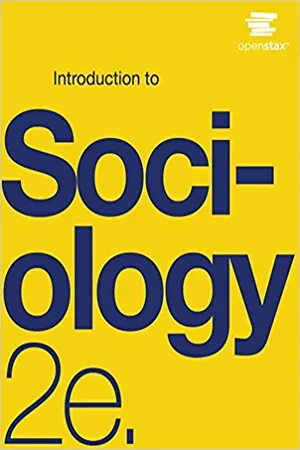Social Sciences
Stratification and Differentiation
Stratification refers to the hierarchical arrangement of individuals or groups within a society based on factors such as wealth, power, and social status. Differentiation, on the other hand, involves the process of creating diversity or specialization within a society, often leading to the development of distinct social roles and functions. Both concepts are central to understanding the structure and dynamics of social systems.
Written by Perlego with AI-assistance
Related key terms
1 of 5
12 Key excerpts on "Stratification and Differentiation"
- Ken Browne(Author)
- 2017(Publication Date)
- Polity(Publisher)
5Stratification and DifferentiationTOPIC 1
Stratification and Differentiation by social class, gender, ethnicity and age (pages 276–302)Introducing Stratification and Differentiation (pages 276–278)
- ➤ Differentiation is the way in which people perceive and treat each other as different.
- ➤ Stratification is where this differentiation becomes the basis for dividing societies into a hierarchy of unequal social groups.
- ➤ Stratification systems may be based on religion, or more commonly on economic factors.
- ➤ A stratification system may be:
- ➠ An open system – where individuals achieve their positions, and there is the opportunity for social mobility, where people can move between strata.
- ➠ A closed system – where social position is ascribed (fixed) at birth, nothing can alter it and there is no chance of social mobility.
- ➤ Groups in the stratification hierarchy will have different amounts of power or authority:
- ➠ Power – the ability of some individuals or groups to get their own way in particular situations.
- ➠ Authority – when the exercise of power is seen as legitimate or justified, and so is accepted by others.
- ➤ Inequality is a feature of all stratification systems, and is becoming more widely used to replace the terms ‘Stratification and Differentiation’. Inequality involves three interlinked ideas:
- ➠ Inequality of opportunity – not everyone has the same chance to pursue success because of artificial, socially created barriers.
- ➠ Inequality of access – not everyone has the same rights and opportunities to access the same valued goods or services of some kind, e.g. schools.
- ➠ Inequality of outcome
- eBook - PDF
- Ruth Wodak, Barbara Johnstone, Paul E Kerswill, Ruth Wodak, Barbara Johnstone, Paul E Kerswill(Authors)
- 2010(Publication Date)
- SAGE Publications Ltd(Publisher)
In sociology, the term ‘social stratifi-cation’ refers to the hierarchical arrangement of groups within a society, and the term can be used in both broad and narrow senses. In a narrow sense, stratification ‘can imply a commitment to a particular way of thinking about inequality, as seeing society as structured layers. … In the increasingly used wider meaning, stratification is concerned with all facets, mechanisms and proc-esses that generate, sustain, and describe social inequalities’ (Savage, 2005: 250). Sociological studies of social stratification tend to investigate systematic, structured inequality along a few different dimensions. A first major concern is how to identify the different forms of stratification that are found in a society and how they are organized. For example, achieved characteristics such as power, wealth and prestige play a significant role in dividing people into hierarchically-ranked social groups, but so do ascribed characteristics like race and gender. In a given society, which of these forms are found and which are most relevant? Other aspects of this first major concern surround how social classes or castes, etc., should be labeled and imposed (e.g. upper-middle class, lower-working class). A second major concern is how conceptually to approach social stratification, to develop various theories about its forms, to compare stratification across societies, and to examine how stratification changes over time. For example, Marx traced the history of various modes of production in different societies and, as a result of his study, predicted the collapse of the capitalist system. Finally, a third major concern in studies of social stratifica-tion deals with the processes and conditions of stratification – in short, how groups in power maintain their privileges, how disadvantaged groups try to get ahead, and the consequences of cohesive or conflicting social relationships in any given society. - eBook - PDF
Sociology
The Essentials
- Margaret L. Andersen; Howard F. Taylor, Margaret Andersen, Howard Taylor(Authors)
- 2016(Publication Date)
- Cengage Learning EMEA(Publisher)
All Rights Reserved. May not be copied, scanned, or duplicated, in whole or in part. Due to electronic rights, some third party content may be suppressed from the eBook and/or eChapter(s). Editorial review has deemed that any suppressed content does not materially affect the overall learning experience. Cengage Learning reserves the right to remove additional content at any time if subsequent rights restrictions require it. 170 CHAPTER 8 Social Differentiation and Social Stratification All social groups and societies exhibit social differentia-tion. Status , as we have seen earlier, is a socially defined position in a group or society. Different statuses develop in any group, organization, or society. Think of a sports organization. The players, the owners, the managers, the fans, the cheerleaders, and the sponsors all have a different status within the organization. Together, they constitute a whole social system, one that is marked by social differentiation. Two scenarios, one society. The difference is the mark of a society built upon class inequality. The signs are all around you. Think about the clothing you wear. Are some labels worth more than others? Do others in your group see the same marks of distinction and status in clothing labels? Do some people you know never seem to wear the “right” labels? Whether it is clothing, bathrooms, schools, homes, or access to health care, the effect of class inequality is enormous, giving privileges and resources to some and leaving others struggling to get by. Great inequality divides society. Nevertheless, most people think that equal opportunity exists for all in the United States. The tendency is to blame individuals for their own failure or attribute success to individual achievement. Many think the poor are lazy and do not value work. At the same time, the rich are admired for their supposed initiative, drive, and motivation. - eBook - ePub
An Introduction to Sociology
Feminist Perspectives
- Pamela Abbott, Melissa Tyler, Claire Wallace(Authors)
- 2006(Publication Date)
- Routledge(Publisher)
Sociologists use the term stratification to refer to a structure according to which individuals and groups are positioned within a social hierarchy in which some groups occupy more powerful and privileged positions than others – in a class, caste or gender system, for instance. Macionis and Plummer (2002) argue that social stratification is:- a characteristic of society – not simply a reflection of individual differences or competences;
- persistent over generations (although some individuals do experience social mobility – see below);
- universal but variable – stratification is a feature of all societies from the simplest to the most complex, but what counts as inequality varies between and also within societies;
- not simply material but also based on belief systems – just as what constitutes inequality varies between societies, so do explanations of why people are unequal, as does the basis on which people might come to be thought of as inferior.
The basis of stratification – the division of people according to a hierarchical system – varies from society to society. Divisions may be based on sexual difference, social class, race and ethnicity, culture, disability, age, and so on. Feminist writer Iris Marion Young (1990a, pp. 49–59) has identified a number of social processes at work in the stratification of societies into hierarchical orders. These include:- social exclusion and marginalisation – a process by which ‘a whole category of people is expelled from useful participation in social life’;
- exploitation – through which there is ‘a transfer of the results of the labour of one social group to benefit another’;
- powerlessness – whereby ‘people come to lack the authority, status and sense of self that many professionals tend to have’;
- cultural imperialism – involving ‘the universalization of a dominant group’s experience and culture, and its establishment as the norm’;
- violence – directed at members of a group simply because they belong to that group (examples of which might include violence against women, racial violence and homophobia).
Sociologists have tended to argue that in capitalist societies the primary form of stratification is based on social class. However, sociologists disagree about what constitutes class, and how it is determined. Some argue, for instance, that countries such as Britain and the US are increasingly ‘classless’. Others emphasise that class is no longer defined by production (the occupational group to which we belong, or by our income) but by consumption (our spending patterns and the kind of lifestyle we adopt). Most sociologists maintain, however, that - eBook - PDF
Sociology
The Essentials
- Margaret Andersen, Margaret Andersen, Howard Taylor(Authors)
- 2019(Publication Date)
- Cengage Learning EMEA(Publisher)
This belief is so much a part of American culture that, when people fail, they tend to be blamed for their lack of success or individual achievement. Thus, many think the poor are lazy and do not value work. At the same time, the rich are admired for their supposed initiative, drive, and motivation. Neither is an accurate portrayal. There are many hardworking individuals who are poor, but they seldom get credit for their effort. At the same time, many of the richest people have inherited their wealth or have had access to resources (such as the best schools or access to elite networks) that others can barely imagine. Observing and analyzing class inequality is fundamental to sociological study. What features of society cause different groups to have different opportunities? Why is there such an unequal allocation of society’s resources? Sociologists respect individual achievements but have found that the greatest cause for disparities in material success is the organization of society. Instead of understanding inequality as the result of individual effort, sociologists study the social structural origins of inequality. Social Differentiation and Social Stratification All social groups and societies exhibit social differentiation. Status, as we have seen earlier, is a socially defined position in a group or society. Different statuses develop in any group, organization, or society. Think of a sports organization. The players, the owners, the managers, the fans, the cheerleaders, and the sponsors all have a different status within the organization. Together, they constitute a whole social system, one that is marked by social differentiation. Status differences can become organized into a hierarchical social system. Social stratification is a relatively fixed, hierarchical arrangement in society by which groups have different access to resources, power, and perceived social worth. Social stratification is a system of structured social inequality. - eBook - ePub
Contemporary Society
An Introduction to Social Science
- John Perry, Erna Perry(Authors)
- 2016(Publication Date)
- Routledge(Publisher)
Chapter 7© Rawpixel.com/ShutterstockThe Great Divide: Ranking and StratificationIN THIS CHAPTER, YOU WILL LEARN THAT• people are differentiated by gender and age in all societies; in societies that produce a surplus they are also differentiated by the amount of wealth, prestige, and power they hold;• the importance of such differentiation lies in the social meanings that are attached to it;• ranking inherently results in inequality because it implies that some persons are superior to others because of the desirable attributes or commodities they possess;• a stratified system results when scarce goods are distributed unequally;• the theoretical explanations for inequality follow a conservative or liberal tradition;• social scientists have developed several models of stratification systems;• there are various ways of determining social class;• the consequences of social class and the factors involved in social mobility affect human lives; and• poverty seems to be a stubborn side effect of inequality.G overnments proclaim that their citizens are all equal before the law. Religions stress that all people are “God’s children.” Scientists assert that all humankind is descended from a common stock. Humanitarians lobby for legislation to equalize the lifestyles of all members of society, and communist governments maintained—before their almost universal collapse—that they had already attained such equality. Philanthropists donate money for the same purpose—or to lessen their guilt for having so much more than others. In short, the idea that all humans are, or should be, equal is a frequent theme, at least in the cultures of Western societies. And yet, perhaps the very insistence on this theme reflects the reality that people are anything but equal.As we saw in Chapter 5 - eBook - PDF
- Diana Kendall(Author)
- 2020(Publication Date)
- Cengage Learning EMEA(Publisher)
Although most slaves were powerless to bring about change, some were able to challenge slavery—or at least their position in the system—by engaging in activities such as sabotage, wealth or power, may find themselves at the bottom of the social hierarchy. Similarly, all societies differentiate between females and males: Women are often treated as subordinate to men. From society to society, people are also treated differently as a result of their religion, race/ ethnicity, appearance, physical strength, disabilities, or other distinguishing characteristics. All of these differentiations result in inequality. However, systems of stratification are also linked to the specific economic and social structure of a society and to a nation’s position in the system of global stratification, which is so significant for understanding social inequality that we devote the next chapter to this topic. Systems of Stratification One of the most important characteristics of systems of stratification is their degree of flexibility. Sociologists dis- tinguish among such systems based on the extent to which they are open or closed. In an open system, the boundaries between levels in the hierarchies are more flexible and may be influenced (positively or negatively) by people’s achieved statuses. Open systems are assumed to have some degree of social mobility. Social mobility is the movement of indi- viduals or groups from one level in a stratification system to another. This movement can be either upward or down- ward. Intergenerational mobility is the social movement expe- rienced by family members from one generation to the next. For example, Sarah’s father is a carpenter who makes good wages in good economic times but is often unemployed when the construction industry slows to a standstill. Sarah becomes a neurologist, earning $350,000 a year, and moves from the working class to the upper-middle class. - eBook - PDF
Cultural Anthropology
An Applied Perspective
- Gary Ferraro, Susan Andreatta(Authors)
- 2017(Publication Date)
- Cengage Learning EMEA(Publisher)
Some people—and entire groups of people— have little or no access to the basic resources of the societies. Various groups in stratified societies, then, are noticeably different in social position, wealth, lifestyle, access to power, and standard of living. The unequal access to rewards found in stratified societies is gener-ally inheritable from one generation to the next. Although distinctions in wealth, power, and prestige began to appear in the early Neolithic period (approxi-mately 10,000 years ago), the emergence of truly strati-fied societies is closely associated with the rise of civiliza-tion approximately 5,500 years ago. A basic prerequisite for civilization is a population with a high degree of role specialization. As societies become more specialized, the system of social stratification also becomes more com-plex. Different occupations or economic interest groups do not have the same access to wealth, power, and pres-tige but rather are ranked relative to one another. As a general rule, the greater the role specialization in a society, the more complex is its system of stratification. Class versus Caste Social scientists generally recognize two different types of stratified societies: those based on class and those based on caste . The key to understanding this funda-mental distinction is social mobility . In class systems, a certain amount of upward and downward social mobility exists. In other words, individuals can change their social position dramatically within a lifetime. Individuals, through diligence, intelligence, and good luck, could go from rags to riches; conversely, people born to millionaire parents could wind up as home-less street people (Newman 1988). Caste societies, on the other hand, have little or no social mobility. Membership in a caste is determined by birth and lasts throughout one’s lifetime. - eBook - PDF
- David Grusky(Author)
- 2019(Publication Date)
- Routledge(Publisher)
On the assumption that the continuity of a society depends on the continuity and sta-bility of its normative order, some such dis-tinction between conformists and deviants seems inescapable. II/ Forms and Sources or Stratification It also seems to be unavoidable that in any society, no matter how literate its tradition, the older, wiser and more experienced individ-uals who are charged with the enculturation and socialization of the young must have more power than the young, on the assump-tion that the task of effective socialization de-mands such differential power. But this differentiation in prestige between the conformist and the deviant is by no means the same distinction as that between strata of individuals each of which operates within the normative order, and is composed of adults. The latter distinction, in the form of differen-tiated rewards and prestige between social strata is what Davis and Moore, and most so-ciologists, consider the structure of a stratifi-cation system. The former distinctions have nothing necessarily to do with the workings of such a system nor with the efficiency of motivation and recruitment of functionally important personnel. Nor does the differentiation of power be-tween young and old necessarily create differ-entially valued strata. For no society rates its young as less morally worthy than its older persons, no matter how much differential power the older ones may temporarily enjoy. (7) Therefore, social inequality among dif-ferent strata in the amounts of scarce and de-sired goods, and the amounts of prestige and esteem which they receive, is both positively functional and inevitable in any society. If the objections which have heretofore been raised are taken as reasonable, then it may be stated that the only items which any society must distribute unequally are the power and property necessary for the perfor-mance of different tasks. - Adrian Furnham(Author)
- 2015(Publication Date)
- Routledge(Publisher)
Chapter nine Social class and stratificationIntroductionAmongst the most noticeable features of society is the existence of human inequalities associated with social differences and the stratification of society. The structures and institutions of society ensure continuing social inequalities and stratification, the sometimes highly unequal status quo, from generation to generation. A number of social mechanisms for generating acceptance or support of inequalities and stratification are routinely presented in analyses of social structure. These include: the demands of the system of political economy; the influence of property and money interests on government and throughout society; coercion by the powerful, the conservative influence of the mass media; people’s fear of major change and losing their established way of life, their hopes for a better future (including possible upward mobility), their feelings of powerlessness; the inability of many to imagine an alternative type of society; and the perceived basic or natural legitimacy of inequalities and stratification.Despite their differences and disagreements, social analysts regard legitimation of social class as important in the maintenance of inequalities and stratification because it promotes their acceptance or support. Legitimation refers to the extremely widespread view that some inequalities in the distribution of resources such as riches, income, power and status, together with accompanying social differences, are justified and desirable. Clearly the specific arguments used to support this view vary among individuals and groups from one time and place to another, as do beliefs about the desirability of different types and patterns of inequality. Research evidence from around the world indicates consistently that a negligible proportion of any nation’s populace holds to an egalitarian view though, of course, dissatisfaction with prevailing inequalities and social differences is not uncommon.- eBook - ePub
Inequality
Classic Readings in Race, Class, and Gender
- David Grusky, Szonja Szelenyi(Authors)
- 2018(Publication Date)
- Routledge(Publisher)
What does seem to be unavoidable is that differential prestige shall be given to those in any society who conform to the normative order as against those who deviate from that order in a way judged immoral and detrimental. On the assumption that the continuity of a society depends on the continuity and stability of its normative order, some such distinction between conformists and deviants seems inescapable.It also seems to be unavoidable that in any society, no matter how literate its tradition, the older, wiser and more experienced individuals who are charged with the enculturation and socialization of the young must have more power than the young, on the assumption that the task of effective socialization demands such differential power.But this differentiation in prestige between the conformist and the deviant is by no means the same distinction as that between strata of individuals each of which operates within the normative order, and is composed of adults. The latter distinction, in the form of differentiated rewards and prestige between social strata is what Davis and Moore, and most sociologists, consider the structure of a stratification system. The former distinctions have nothing necessarily to do with the workings of such a system nor with the efficiency of motivation and recruitment of functionally important personnel.Nor does the differentiation of power between young and old necessarily create differentially valued strata. For no society rates its young as less morally worthy than its older persons, no matter how much differential power the older ones may temporarily enjoy.(7) Therefore, social inequality among different strata in the amounts of scarce and desired goods, and the amounts of prestige and esteem which they receive, is both positively functional and inevitable in any society.If the objections which have heretofore been raised are taken as reasonable, then it may be stated that the only items which any society must distribute unequally are the power and property necessary for the performance of different tasks. If such differential power and property are viewed by all as commensurate with the differential responsibilities, and if they are culturally defined as resources - eBook - PDF
- Heather Griffiths, Nathan Keirns, Eric Strayer, Susan Cody-Rydzewski, Gail Scaramuzzo, Tommy Sadler, Sally Vyain, Jeff Bry, Faye Jones(Authors)
- 2015(Publication Date)
- Openstax(Publisher)
Social mobility describes a shift from one social class to another. Class traits, also called class markers, are the typical behaviors, customs, and norms that define each class. 9.3 Global Stratification and Inequality Global stratification compares the wealth, economic stability, status, and power of countries as a whole. By comparing income and productivity between nations, researchers can better identify global inequalities. 9.4 Theoretical Perspectives on Social Stratification Social stratification can be examined from different sociological perspectives—functionalism, conflict theory, and symbolic interactionism. The functionalist perspective states that systems exist in society for good reasons. Conflict theorists observe that stratification promotes inequality, such as between rich business owners and poor workers. Symbolic interactionists examine stratification from a micro-level perspective. They observe how social standing affects people’s everyday interactions and how the concept of “social class” is constructed and maintained through everyday interactions. Section Quiz 9.1 What Is Social Stratification? 1. What factor makes caste systems closed? a. They are run by secretive governments. b. People cannot change their social standings. c. Most have been outlawed. d. They exist only in rural areas. 2. What factor makes class systems open? a. They allow for movement between the classes. b. People are more open-minded. c. People are encouraged to socialize within their class. Chapter 9 | Social Stratification in the United States 199 d. They do not have clearly defined layers. 3. Which of these systems allows for the most social mobility? a. Caste b. Monarchy c. Endogamy d. Class 4. Which person best illustrates opportunities for upward social mobility in the United States? a. First-shift factory worker b. First-generation college student c. Firstborn son who inherits the family business d. First-time interviewee who is hired for a job 5.
Index pages curate the most relevant extracts from our library of academic textbooks. They’ve been created using an in-house natural language model (NLM), each adding context and meaning to key research topics.











